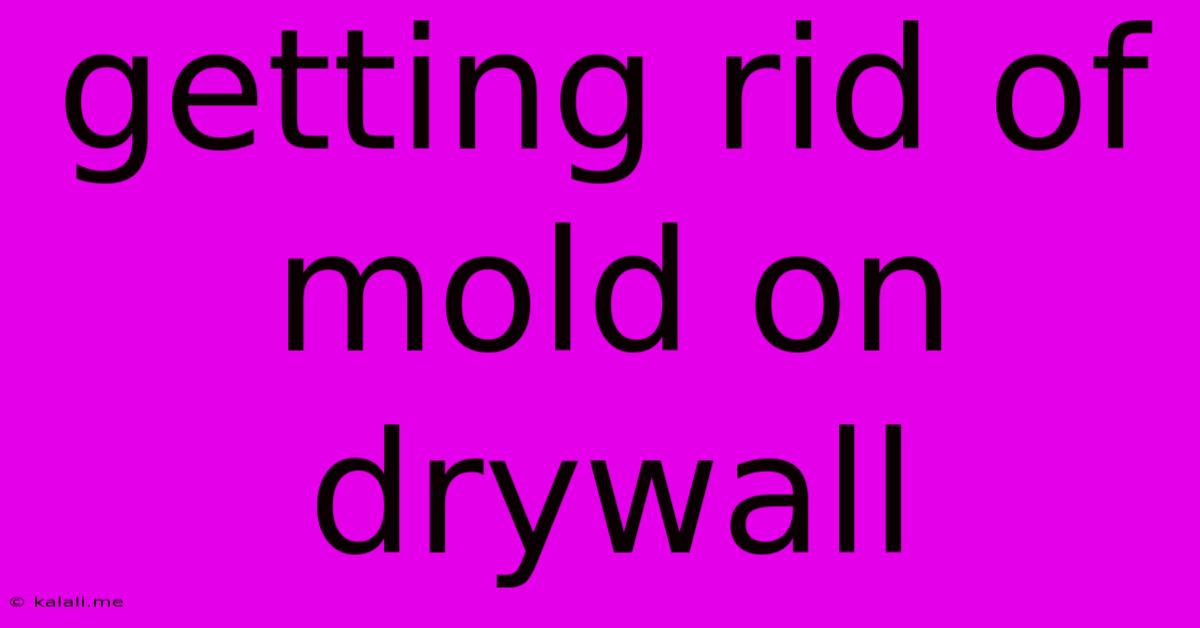Getting Rid Of Mold On Drywall
Kalali
Jun 06, 2025 · 3 min read

Table of Contents
Getting Rid of Mold on Drywall: A Comprehensive Guide
Mold on drywall is a serious issue, impacting both the aesthetics and health of your home. This guide provides a comprehensive approach to mold removal, from identification and prevention to safe and effective remediation techniques. Ignoring mold growth can lead to respiratory problems and structural damage, so acting quickly is crucial. This article will equip you with the knowledge and steps to tackle mold effectively and safely.
Identifying Mold on Drywall
Before tackling mold removal, accurate identification is key. Mold manifests in various colors, including black, green, gray, white, and even orange. It often appears as fuzzy patches, slimy spots, or discoloration on the drywall surface. Pay close attention to areas with high humidity like bathrooms, kitchens, and basements. If you suspect mold, don't hesitate to investigate further.
Areas prone to moisture damage, such as water leaks or condensation, are prime locations for mold growth. Inspect around pipes, windows, and any area that's experienced recent water damage. A musty odor is another telltale sign of a mold problem. If you have any doubts, consult a professional mold inspector for a thorough assessment.
Assessing the Mold Infestation
The extent of the mold infestation dictates the approach to its removal. Small, isolated spots of mold might be manageable with DIY methods, while larger or widespread infestations require professional help. A small patch of mold, less than 10 square feet, might be tackled at home, provided proper safety precautions are followed. However, infestations exceeding this size, or those involving black mold (Stachybotrys chartarum), warrant the attention of a professional mold remediation specialist. Black mold requires specialized equipment and expertise due to its potential health risks.
Safe Mold Removal Techniques for Small Infestations
1. Preparation is Key: Before starting any mold removal, protect yourself. Wear an N95 respirator mask, gloves, and eye protection. Also, ensure proper ventilation by opening windows and doors to allow fresh air circulation. Contain the affected area using plastic sheeting to prevent mold spores from spreading.
2. Cleaning Solution: A simple solution of water and bleach (1 cup bleach per gallon of water) is often effective for small mold patches. Always test the solution in an inconspicuous area first to check for any discoloration or damage to the drywall.
3. Scrubbing and Drying: Apply the cleaning solution to the moldy area using a stiff brush or sponge. Scrub gently to avoid damaging the drywall. Rinse thoroughly with clean water and allow the area to dry completely. Use fans or dehumidifiers to expedite the drying process and prevent future mold growth.
4. Monitoring and Prevention: After cleaning, carefully monitor the area for any signs of recurring mold growth. Address any underlying moisture problems promptly. Repair leaks, improve ventilation, and use dehumidifiers to maintain a dry environment and prevent mold from returning.
When to Call a Professional
Larger mold infestations, particularly those involving black mold, require professional intervention. Professionals have the expertise, equipment, and safety protocols to handle extensive mold problems safely and effectively. They can properly assess the extent of the damage, remove the mold safely, and address any underlying issues that contributed to its growth, preventing future recurrences. They also possess the knowledge to dispose of the contaminated materials responsibly, preventing further spread.
Preventing Future Mold Growth
Prevention is always better than cure. Implementing the following steps can significantly reduce the likelihood of mold growth in your home:
- Maintain proper ventilation: Ensure adequate airflow in bathrooms and kitchens by using exhaust fans.
- Address leaks promptly: Repair any leaks or water damage immediately to prevent moisture buildup.
- Use dehumidifiers: In damp areas, use dehumidifiers to maintain low humidity levels.
- Regular cleaning: Regularly clean and disinfect areas prone to mold growth.
- Improve insulation: Proper insulation prevents condensation and keeps walls dry.
By understanding the causes, identification, and remediation of mold, you can protect your home and your health. Remember, early detection and prompt action are crucial for effective mold control. If you're unsure about tackling mold removal yourself, always seek professional help.
Latest Posts
Latest Posts
-
Google Sheets Insert Row Above Shortcut
Jun 07, 2025
-
Configure Error C Compiler Cc Is Not Found
Jun 07, 2025
-
How To Treat Mold On Concrete
Jun 07, 2025
-
Opinions Of Heath Ledger When Cast As Joker
Jun 07, 2025
-
How To Match Tires To Rims
Jun 07, 2025
Related Post
Thank you for visiting our website which covers about Getting Rid Of Mold On Drywall . We hope the information provided has been useful to you. Feel free to contact us if you have any questions or need further assistance. See you next time and don't miss to bookmark.